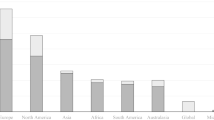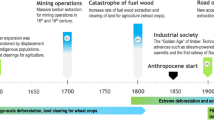Abstract
Many Aboriginal groups, in northern Canada and elsewhere, recognize the strong relationship between the health and well-being of people and environment. Western science, including theory and literature related to forest ecosystem management, has been slow to recognize the complex and diverse values that Aboriginal people associate with their lands and resources. Through case study research on the berry-harvesting practices of Gwich’in women from the community of Fort McPherson, Northwest Territories, Canada, we investigated the values that Teetl’it Gwich’in women associate with the land or nan kak. Nine different values, as well as a set of detailed measures, were identified during the research, including individual preference and well-being, family well-being, social connectivity, cultural continuity, land and resource use, stewardship, self-government, and spirituality. The commercial value of berries was not identified as important to women. This interdisciplinary research has the potential to contribute to several bodies of literature including that on social-ecological systems.



Similar content being viewed by others
References
N Adelson (2000) Being Alive Well: Health and the Politics of Cree Well-Being University of Toronto Press Toronto
A Andre A Fehr (2001) Gwich’in Ethnobotany: Plants used by the Gwich’in for Food, Medicine, Shelter and Tools Gwich’in Social and Cultural Institute and Aurora Research Institute Tsiigehtchic, NT
Beckley T (1999) Sustainability for whom? Social indicators for forest dependent communities in Canada, Edmonton: Sustainable Forest Management Network. Available: http://sfm-1.biology.ualberta.ca/
Beckley T, Burkosky T (1999) Social indicator approaches to assessing and monitoring forest community sustainability: Northern Forestry Centre Information Report NOR-X-360, Natural Resources Canada, Canadian Forest Service
F Berkes (1999) Sacred Ecology: Traditional Ecological Knowledge and Resource Management Taylor and Francis Philadelphia
F Berkes J Colding C Folke (Eds) (2003) Navigating Social-Ecological Systems: Building Resilience for Complexity and Change Cambridge University Press Cambridge, UK
F Berkes M Kislalioglu C Folke M Gadgil (1998) ArticleTitleExploring the basic ecological unit: ecosystem-like concepts in traditional societies Ecosystems 1 409–415 Occurrence Handle10.1007/s100219900034
R Brightman (1993) Grateful Prey: Rock Cree Human-Animal Relationships University of California Press Berkley, CA
I Davidson-Hunt F Berkes (2003) ArticleTitleLearning as you journey: Anishinaabe perceptions of social-ecological environments and adaptive learning Conservation Ecology 8 5
Davidson-Hunt I, Duchesne LC, Zasada JC (editors) (2001). Forest Communities in the Third Millennium: Linking Research, Business, and Policy toward a Sustainable Non-timber Forest Product Sector, St. Paul, MN: USDA Forest Service. Available: http://www.consecol.org/vol8/iss1/art5
GCLCA Gwich’in Comprehensive Land Claim Agreement (1992) Available: http://www.ainc-inac.gc.ca/pr/agr/gwich/gwic_e.html
M Heime A Andre I Kritsch A Cardinal (2001) Gwichya Gwich’in Googwandak: The History and Stories of the Gwichya Gwich’in Gwich’in Social and Cultural Institute Tsiigehtchic, NT
P Howard (Eds) (2003) Women and Plants: Gender Relations in Biodiversity Management and Conservation Zed Books London
L Main-Johnson (2000) ArticleTitle“A place that’s good,” Gitksan landscape perception and ethnoecology Journal of Human Ecology 28 301–325 Occurrence Handle10.1023/A:1007076221799
R Marles C Clavelle L Monteleone N Tays D Burns (2000) Aboriginal Plant Use in Canada’s Northwest Boreal Forest University of British Columbia Press Vancouver
A McMichael C Butler C Folke (2003) ArticleTitleNew visions for addressing sustainability Science 302 1919–1920 Occurrence Handle10.1126/science.1090001 Occurrence Handle14671290
InstitutionalAuthorNameMEA (2003) Millennium Ecosystem Assessment—Ecosystems and human well-being. A framework for assessment Island Press Washington DC
D Natcher C Hickey (2002) ArticleTitlePutting the community back into community-based resource management: a criteria and indicators approach to sustainability Human Organization 61 350–363
R Nelson (1986) Hunters of the Northern Forest: Designs for Survival among the Alaskan Kutchin University of Chicago Press Chicago
B Parlee (1998) Community-based Monitoring: a Guide for Northern Communities Canadian Arctic Resources Committee Ottawa
B Parlee M Manseau Lutsel K’e Dene First Nation (2005a) Understanding and communicating about ecological change: Denesoline indicators of ecosystem health F Berkes R Huebert H Fast M Manseau A Diduck (Eds) Breaking Ice: Integrated Ocean Management in the Canadian North University of Calgary Press Calgary
B Parlee M Manseau K’e Lutsel InstitutionalAuthorNameDene First Nation (2005b) ArticleTitleUsing traditional knowledge to adapt to change: Denesoline monitoring of caribou movements Arctic 53 1
M Roberts W Norman N Minkinnick D Wihongi C Kirkwood (1995) ArticleTitleKaitiakitanga: Maori perspectives on conservation Pacific Conservation Biology 2 7–20
R Slobodin (1962) Band Organization of the Peel River Kutchin (National Museum of Canada Bulletin #179) National Museum of Canada Ottawa
Wilson K (2000) The Role of Mother Earth in Shaping the Health of Anishanabek: A Geographical Exploration of Culture, Health and Place, Kingston: Queen’s University (unpublished doctoral thesis)
K Wilson M Rosenberg (2002) ArticleTitleExploring the determinants of health for First Nations peoples in Canada: can existing frameworks accommodate traditional activities? Social Science and Medicine 55 2017–2031 Occurrence Handle10.1016/S0277-9536(01)00342-2 Occurrence Handle12406468
Acknowledgments
We are grateful to the Teetl’it Gwich’in elders and others from Fort McPherson who were involved in this study as well as the contributions and support of the Gwich’in Renewable Resources Board, the Gwich’in Social and Cultural Institute, and the University of Manitoba. Special appreciation goes to Christine Firth for her hard work and commitment to the research project. The Teetl’it Gwich’in terminology in this article is thanks to Eleanor Mitchell-Firth and Berth Francis. The study was supported by the Sustainable Forest Management Network (SFMN) through a research grant to Dr. Fikret Berkes.
Author information
Authors and Affiliations
Corresponding author
Rights and permissions
About this article
Cite this article
Parlee, B., Berkes, F. & Gwich’in, T. Health of the Land, Health of the People: A Case Study on Gwich’in Berry Harvesting in Northern Canada. EcoHealth 2, 127–137 (2005). https://doi.org/10.1007/s10393-005-3870-z
Published:
Issue Date:
DOI: https://doi.org/10.1007/s10393-005-3870-z




